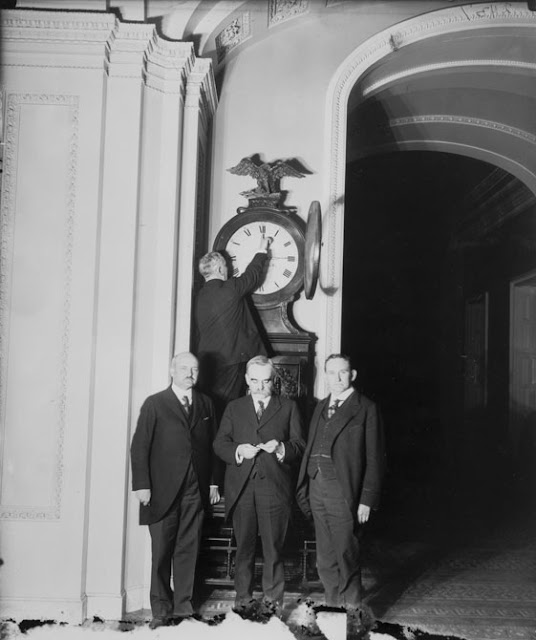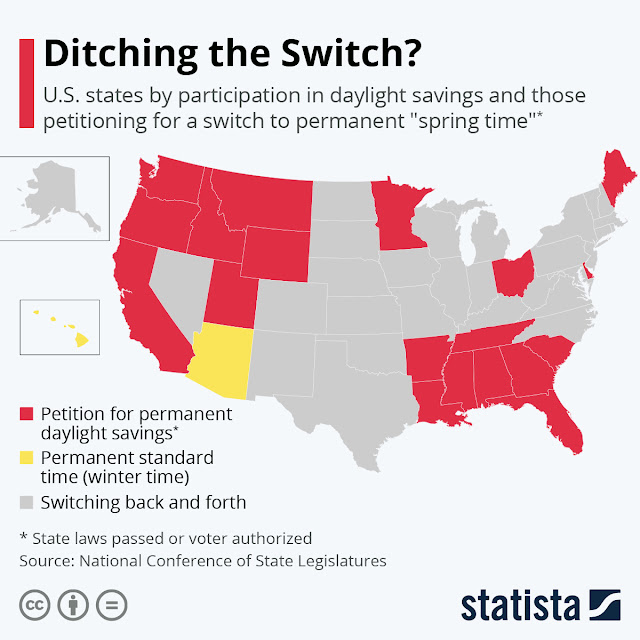Almost everyone in America will revel in an extra hour of sleep tomorrow morning. It happens
every year, no matter how many announcements
are made on the TV news, radio,
newspapers, and now by cute Facebook
memes. And some folks who did fiddle with their time pieces get it wrong—is it spring forward, fall back or the other way around?
Anyway,
here is a heads up to set your clocks back tonight before you got
to bed. Or if you are a stickler
for accuracy wait until 2 am Sunday to set them back to 1
am.
It’s
vexing. And some think, foolish. Take to oft quoted bit of folk wisdom usually ascribed to some Native American sage—Daylight
Savings Time is like cutting a strip
off the bottom of the blanket and sewing it to the top and thinking you have a longer
blanket.
Perhaps. But maybe there is something to it. People
have been doing it, or something
very like it, for a long time.
Way
back when togas were in fashion, those wily old Romans
had water clocks inscribed with two sets of numerals—one
for summer and one for winter.
And all of those years when there essentially were no clocks, peasants and farmers regulated their lives by the sun—beginning their days
with its rise and ending their labors with its setting. All pretty much the same idea as DST.
Benjamin Franklin, an early riser and frugal man, is sometimes credited with the idea. He wanted to save money on candles. As Minister to France in 1782 he found time to publish an essay, An Economical Project for Diminishing the Cost of Light. He proposed adjusting hours to rise earlier in the warm months so that work could be illuminated through an open window, not by costly bee’s wax candles. But no one took him up on his utilitarian proposal.
Benjamin Franklin is often credited or blamed for inventing the idea of Daylight Savings Time. His proposal in a French journal may have been a satire. Anyway, it got nowhere.A similar notion was floated by New Zealand entomologist George Vernon
Hudson more than a century later in 1895.
In a paper presented to the Wellington
Philosophical Society he proposed a two-hour shift forward in October and a
two-hour shift back in March. Remember Kiwi land is in the Southern Hemisphere and seasons are reversed. There was
some interest, but two hours probably seemed like a drastic, wrenching change. Nobody picked up his idea.
In
1905 Englishman William Willett came
up with a gentler approach. He proposed moving the clocks 20 minutes forward each of four Sundays in April and switching them back by the same amount on four Sundays in
September. This, he reasoned would allow for gradual adjustment, much the same as naturally rising and beginning work with the Sun. Liberal
Member of Parliament Robert Pearce introduced the first Daylight Saving Bill to the House of Commons on February 12, 1908. And there it languished, year after year
despite constant lobbying and public appeals by Willett right up to
his death in 1915.
As
is so often the case, it took a war to accelerate innovation. World
War I, to be exact. Imperial Germany instituted Sommerzeit—Summer Time—as a fuel conservation war measure on April 30, 1916. Britain and France soon followed. Russia did it in 1917. And when the U.S. decided to go Over There, the Wilson
administration adopted it in 1918.
The
United States quickly abandoned
Daylight Savings time after the war. Farmers, who had once regulated their lives
by the sun, now complained that
the cows needed milking and the chickens demanded to be fed at set, familiar hours which were disrupted
by the sudden hour changes. But then farmers tend to be traditionalists
and despise any change. But they were a powerful political force.
President Franklin D. Roosevelt proclaimed, War Time on February 9, 1942. It essentially was year-round Daylight Savings Time.
In Britain, where fuel was at a
premium, Double Summer Time was
applied which moved the clocks two hours ahead of Greenwich Mean Time (GMT) during the summer and one hour ahead of
GMT during the winter. America abandoned
its War Time in September of 1945.
After the War, many states, and sometimes local jurisdictions, continued to use
Daylight Savings Time in the warmer
months. Starting and ending times
varied and the result was a patch
work map of Daylight and Standard
Time. It was hell on railroads and airlines, who needed consistent schedules, inconvenient for the national broadcasting networks, and a pain
in the ass a lot of folks who found
their jobs and residences in different
times.
A clamor grew to straighten the whole damn mess out. But no
compromise could be found between those who wanted to return to year-round Standard Time
and those who wanted uniform Daylight Savings Time in warmer months.
Congress finally adopted
the Uniform Time Act of 1966
providing that DST would begin on the last
Sunday of April and end on the last Sunday of October. States
could, however, still opt out by passing a local law.
And
of course, some did. It led
to problems. Indiana,
in thrall to its farmers, stubbornly clung to Standard Time. Most of the state was in the Eastern Zone. But a corner of the state around
Gary and Hammond in Northwest was
in the Central Zone. That meant when DST would go into effect in neighboring Illinois, the area became
an island out of sync with
both the rest of its state and
with the Chicago metropolitan area
with which it was economically tied. Similar time
islands were found elsewhere.
After
the Energy Crisis brought about by
the Arab Oil Embargo of 1973,
Congress passed emergency legislation
extending uniform Daylight Savings time for 10 months in 1974. After howls
of protest that children were waiting for school busses in the dark, that was rolled by to 8 months a
year later. In ’76 DST reverted to
beginning on the last Sunday in April.
But
Congress was not done tinkering. Energy conservation benefits of DST were
evident. In 1985 it pushed the start
date back to the first Sunday in April.
The Energy Policy Act of 2005
extended DST by about one month starting on the second Sunday in March and
ending on the first Sunday in November. That went into effect in 2007.
Today
most of the US observes DST except for Hawaii
and most of Arizona, and Puerto Rico, the US Virgin Islands, American
Samoa, and Guam.
And,
oh year folks from Gary no longer have to change their watches every time they drive across the Illinois border.
Meanwhile
new efforts are being made to end it all together. Folks resent messing with their bio-rhythms,
and the bother of changing all of the clocks that are now on almost all appliances. It is widely mocked by late night TV hosts
and in social media posts.
Last
year it looked like Illinois was going to abandon Daylight Savings time,
but a busy legislative schedule meant that the clock ran out on the session
and the incoming legislature would have to begin the whole process over
again from scratch—hearings and conferences between House
and Senate included. So far it has not
advanced in either house this year.
In
the last four years, 19 states have enacted legislation or passed resolutions
to provide for year-round Daylight Saving Time, if Congress were to allow such
a change, and in some cases, if surrounding states enact the same legislation.
Because federal law does not currently allow full-time DST, Congress would have
to act before states could adopt changes.
Two Republican
Federal legislators, with some Democratic co-sponsors are
leading the national effort for the Sunshine Protection Act of 2021.
In January, Congressman Vern Buchanan introduced H.R.69, and in
March Sen. Marco Rubio introduced S.623. Both bills call for DST
to become permanent in the U.S. year-round. With rare bi-partisan appeal the
legislation is thought to have at least a shot of being enacted. The Biden administration has not signaled
its position yet.
If
it comes to pass the Sun will never be directly overhead at noon.







No comments:
Post a Comment